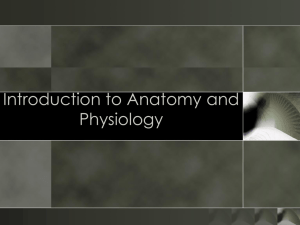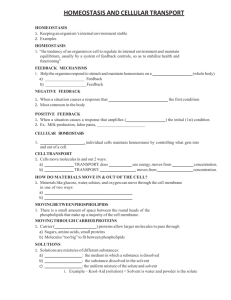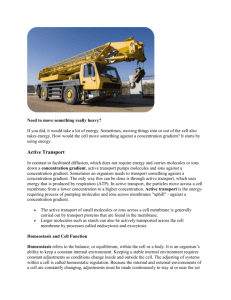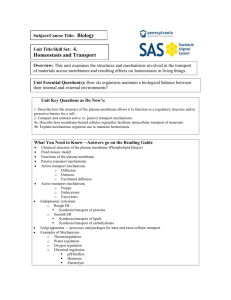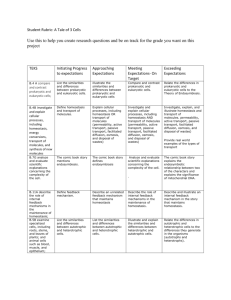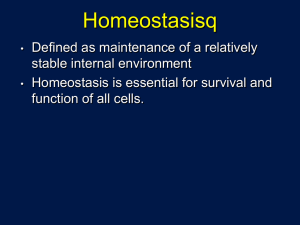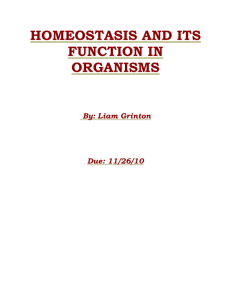Unit 1 - Haiku!
advertisement
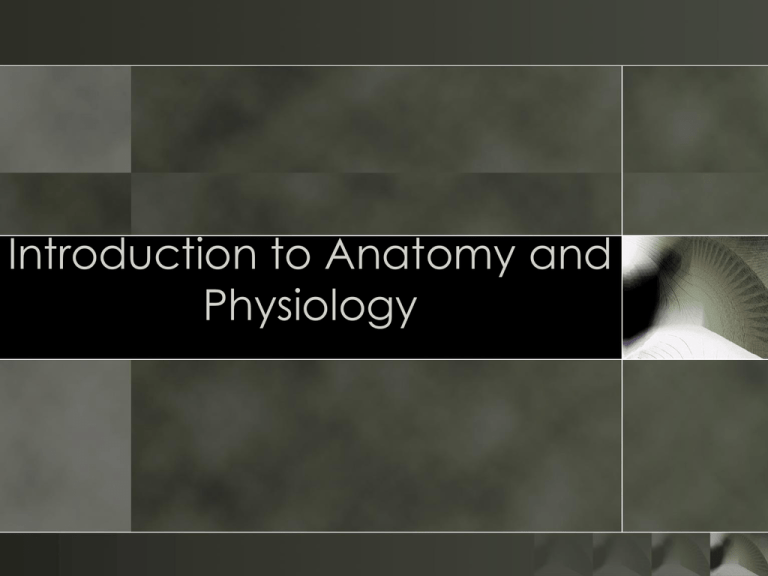
Introduction to Anatomy and Physiology anatomy = “a cutting open” o Study of internal and external structures of the body and the physical relationship between body parts o Ex – a particular bone attached to a muscle physiology o Study of the function of anatomical structures; considers both physical and chemical processes o Ex. how a muscle contracts to move the bone cell: basic unit of life o Cytology o Histology Levels of Organization Homeostasis Objectives: 1. Significance of homeostasis 2. Positive and negative feedback Start here Lots of examples of negative feedback loops, few positive loops For test be able to analyze: o Calcium homeostasis (page 132) o Body temperature (page 7) o Water regulation (refer to notes) o Control center for sympathetic and parasympathetic divisions of PNS o Effectors and response after sympathetic disruption of homeostasis occurs Two ways to maintain homeostasis o Negative feedback o Positive feedback Negative Feedback: example body temperature Q1: compare response to original stimulus o Answer: o The response by the effectors is antagonistic (opposite) of the stimulus Stimulus = body temp ↑ Response = body temp ↓ Q2: homeostasis restored? How do you know? o Answer o Yes, because the response counteracts the stimulus o Brings back balance Positive Feedback: example labor contractions Q3: compare response and stimulus in positive feedback o Answer o The response acts to heighten or increase the stimulus Stimulus = ↑ distortion of uterus Response= ↑ distortion and contraction of uterus Q4: Is homeostasis restored in this example? How do you know? o Answer: o No, homeostasis is continually disrupted o This is a good thing in this case b/c returning to homeostasis would cause the birthing process to stop. o The positive feedback loop will continue until birth is complete. Positive feedback examples o Childbirth o Blood clotting o Sexual orgasm o Milk production from mammary glands Cellular homeostasis Every level of organization within the body must maintain homeostasis Phospholipid Bilayer Diffusion o Diffusion is the movement of molecules from a higher concentration to a lower concentration. o The difference in concentration of two solutions is called the concentration gradient o Demonstration: food coloring in water ttp://www.biosci.ohiou.edu/introbioslab/Bios170/diffusion/Diffusion.h tml Diffusion: Anatomy example o Oxygen gas enter body and blood stream o Carbon dioxide leave blood and body Diffusion across membranes o Molecules that dissolve in lipids can cross the lipid bilayer through diffusion. Example: O2 CO2 H2O Osmosis o Think back to solutions: solutes and solvents o Osmosis is the process by which water molecules diffuse across a cell membrane from an area of lower solute concentration to an area of higher solute concentration. o Direction of movement depends on relative concentrations of solutions. Osmosis: anatomy connection o Excess water versus dehydration o Kidneys help to rid excess water as urine = osmosis of water out of blood (high) into kidneys (low) Direction of movement into cells o Hypotonic to the cytosol o solution outside the cell is less concentrated than inside the cell o water moves into the cell o Hypertonic to the cytosol o solution outside the cell is more concentrated than inside the cell o water moves out of the cell o Isotonic o concentrations are equal o http://www.tvdsb.on.ca/westmin/science/sbi3a1/Cells/Osm osis.htm What about the molecules that can’t pass through the membrane freely? o Glucose, Na+, Ca+, K+ and lots of other molecules need to get into and out of the cell but can’t get through the lipid bilayer o They must use the proteins embedded in the lipid bilayer Facilitated transport o Protein channels embedded in the cell membrane allow ions and other molecules to diffuse into and out of a cell o Where have we seen facilitate diffusion in action? o Neuron’s gated Na+ and K+ channels o Ca+ channels in nerve and muscle cells Active transport o Requires energy to transport molecules across a cell’s membrane Ex. 1 Membrane proteins may serve as pumps to push ions across the cell against the concentration gradient o Examples of pumps? o Na+/K+ pump in neurons Active Transport (con’t) Ex. 2 Exocyotosis – the cell excretes wastes, chemicals or other products by releasing them from vesicles o Where have we seen this? o Release of neurotransmitters Ex 3 Endocytosis – the cell takes in molecules or food by engulfing it o We will see this with immune system and WBCs
